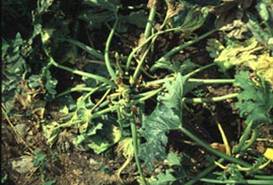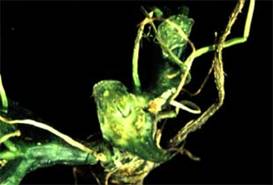Vascular Wilt: Erwinia tracheiphila
Symptoms
-
Symptoms of the disease first appear on a single leaf which suddenly wilts and becomes dull green.
-
The wilting symptoms spread up and down the runner sometimes as a recurring wilt on hot, dry days.
-
Soon infected runners and leaves turn brown and die. The bacteria spread through the xylem vessels of the infected runner to the main stem, then to other runners. Eventually the entire plant shrivels and dies.
-
Less susceptible plants, such as certain squash varieties, may show dwarfing of growth before the wilt symptoms become apparent.
-
A creamy white bacterial ooze consisting of thousands of microscopic, rod-shaped bacteria may sometimes be seen in the xylem vascular bundles of an affected stem if it is cut crosswise near the ground and squeezed.
-
This bacterial ooze will string out forming fine, shiny threads (like a spider's web) if a knife blade or finger is pressed firmly against the cut surface, then slowly drawn away about 1 cm.
-
Two cut stem ends can also be put together, squeezed, then separated to look for shiny strands of bacteria.
-
The sap of a healthy plant is watery and will not string. Sometimes it helps to wait several minutes after cutting to perform the test.
-
This technique is useful in field diagnosis to separate this disease from other vascular wilts. Beware, however, that the technique may not always work (i.e., no bacterial strings occur yet the plant is still infected). The test works better for cucumbers than for muskmelons.
-
Fruit may also show symptoms. Small water-soaked patches form on the surface. These patches eventually turn into shiny decayed spots on the fruit.
Management
-
Larger plantings must be protected by insecticides. Some carbaryl (Sevin), malathion, or rotenone insecticides or combination products are registered to treat cucumber beetles.
-
They will provide control of the beetles if applied when beetles first appear in the spring. Early control, beginning as soon as the plants emerge, is most important as a single beetle can introduce the bacteria.
-
One to four generations of the beetle may occur on unprotected plants and applications of these insecticides at weekly intervals may become necessary.
-
Apply a light even coating of the insecticide over the entire plant, especially where the stem emerges from the soil (that is where the beetles often congregate).
|
|
Symptoms of yellowing, wilting and dieback of the foliage of squash. |
| |
|
Close up of the symptoms that are capable of infecting roots as well. |
|


